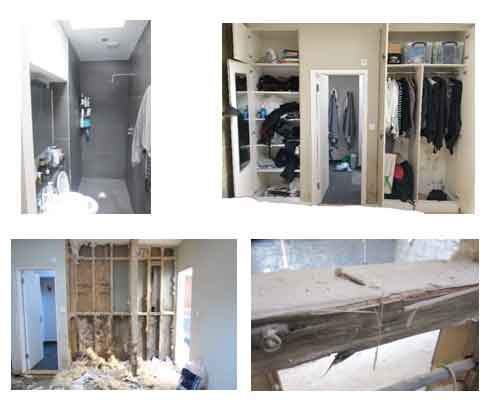Dealing with A Flood or Escape of Water Insurance Claim
A flood in residential or business premises can be devastating. Most freeholders/owners of premises have buildings and contents insurance, but some may have inadequate cover so it pays to check. Some may have no cover. Leaseholders may have buildings insurance via their landlord, recovered through a service charge, at least for the buildings.
The process of making a claim following an incident can be quite daunting, contacting your insurers is the first stage to advise them of the incident, so have your insurance details in more than one place.
The insurer will most likely appoint a ‘loss-adjuster’ to progress the claim by assessing the damage and costs for remedial reinstatement within the terms of the policy. The policy wording is critical here.
'Flood' or Escape-of-water
The terminology is sometimes incorrectly used when one comments they have had a ‘flood’, when in fact the insurer classes the incident as an ‘escape of water’, such as from thawing frozen pipes, burst of a hot water cylinder, burst storage tank or overflowing drains. A flood is a much more catastrophic event, which usually involves rivers, lakes, watercourses, and may be exacerbated by exceptionally inclement weather, and similar.
An escape-of-water incident may affect just part of the structure, whereas the flooding of a building will probably affect basements, ground floor premises and contaminate the floors, plasterwork, finishes, services, structure and belongings/contents.
The more serious incident of flooding needs special consideration in terms of approach, and special measures to deal with the impact of the mass amount of water. The bacterial contamination of items requires a specific action to ensure the contamination is removed from the property.
Many properties affected by flooding have a history of this occurring, whilst others may not. Climate change may increase such events over time. Developments built on flood plains are at higher risk.
With the escape of water damage, one may be able to remain in the property whilst it dries out and the damage is repaired. With flooding, this is unlikely to be the case, as the water will have affected very large areas of the property and contents.
Betterment
Insurers are obliged only to compensate the insured person or persons, to reinstate them back to the same position they were in before the fire or incident. They are not going to fund any improvements, so you will have to fund those yourself. This is the concept of ‘betterment’.
The loss-adjuster is acting purely as an agent for the insurer. Their guidelines in the assessment will be the basis of the policy terms, and they will scrutinize those in detail. Essentially, they will advise the insurer what they think their liability is in terms of cost/fees etc.
You may deal directly with the loss-adjuster in your claim, but you will be doing that at a time when there may be significant emotional upset as a result of the water damage and loss, possibly also the need to find temporary alternative accommodation. For businesses, there will be the added impact of the event on the business, and clients/customers. For landlords, there could be loss of rent and income.
Scale of damage
The initial visit by the loss-adjusters will enable them to identify the scale and extent of the damage. They will take measurements, photographs, and record information. It will be established if other adjoining premises are affected. They may then have some advice for the insured person affected, to mitigate further damage, such as to bring in a contractor to put temporary pumps and dryers to help dry out the structure or to remove hazardous materials, which might still prove to be a risk.
Loss adjusters may ask for a report from specialist services engineers or environmental officers. The local water authority may well be involved if the property has had water ingress from say, a burst water main in the street. The quantity of water may be substantial from a failed water main in the road outside the property and multiple properties might then be affected. The local authority may even be called upon to provide some temporary housing in the short-term.
Inspection and Remedial works
It is important to identify the type of leak or flood that has occurred. Clean white water is easily remedied. Grey and black water will need to be considered further and a strict strip out and sanitation programme completed swiftly.
• Action to strip-out saturated materials to assist with dry out and restoration will be necessary.
• Stripping out saturated materials prevents moisture migrating deep within the property structure and prevents mould growth.
• Specification of correct drying equipment is important, tailored for the type of leak or flood that has occurred, to prevent further damage and reduce drying time and restoration.
• Removing, re-locating furniture at risk, and contents swiftly to offsite storage, or to unaffected areas of the property to prevent secondary damage.
• Affected materials and inaccessible voids need to be considered for the potential of ‘invisible’ damage.
• Fungal attack of the structure may sometimes occur in the longer term, and this needs to be understood at the outset and necessary action taken to mitigate.
Materials
Unless one is trained in this area, few will have a thorough understanding of the impact of water contamination on different building materials, such as gypsum plasterwork, sheet chipboard flooring, timber, kitchen units, floor screeds, masonry walls, pipes, electrical cabling, asbestos, decorations, etc.
Timber work can swell and then shrink and twist as it dries out, when wet it can be affected by fungal attack. Plasterwork can be contaminated with salts and require removal and replacement. A saturated timber staircase might be saved in some situations, following a flood, but not in others. Ceilings and cornices affected may need removal, but what if the building is listed?
The drying process is critical, and much unnecessary damage has been caused to materials when the drying out is delayed or quickly accelerated. Dryers need to be used with extreme care, to avoid further distortion and damage to parts of the structure. The structure needs to be stable to allow remedial works to take place.
Mould, rot and fungal attack
What you don't want is to have your property refurbished and redecorated only to find a year or so later, you have an attack of dry rot, or quantities of fungal mould in cupboards and concealed spaces, which can be hazardous to health.
Issues for consideration
The issues to consider, following water damage to premises are:
• The initial contact with insurers and notification of the insured event.
• The terms of the insurance policy and what it covers, and what it excludes. (This can affect contents of buildings also)
• Whether it is a home or a business, or both residential and commercial affected, or some other category of premises.
• The scale of the flood or water leak and level of damage arising.
• Whether it is possible to use part of the premises or not, and the need for temporary accommodation.
• Have other adjoining premises being affected or is it isolated to one property/dwelling/unit?
• For landlords, whether the water ingress might result in loss of rent to premises which cannot be let.
• For businesses the impact on clients, customers and those who were using the services at the time of the incident.
• Whether the insurance cover via the premiums paid was (a) Valid (b) Adequate (c) Whether premium payments were up to date
• Whether the insurer still existed at the time of the incident, whether they had assigned the insured’s business to others and other relevant facts.
• The scale and nature of the contents that have been damaged or destroyed, as a result of the incident.
• The negotiation with the insurer/loss adjuster, of the financial settlement arising from the loss.
• Costs for things like temporary accommodation, purchase of clothing and basics.
• For businesses, they may have various supplier or service contracts which they still have to fulfil. They may have to pay suppliers or subcontractors, at a time when revenue dries up due to the event.
• Any affected children, older or disabled relatives, pets, animals and their specific needs, particularly in respect of any temporary accommodation
Documentation
One of the greatest concerns can be the loss of documentation, a flood or even an escape of water from pipes and drains can destroy accounts, paper records, files, photographs, certificates, evidence of bank accounts and savings, and even money kept at the premises. These will need to be replaced over time and a great deal of effort may be required to identify what has been destroyed and what has been saved.
Hazardous materials
Furthermore, the flood could have contaminated the property with hazardous materials or dangerous bacteria. Specialists may need to be brought in to remove hazardous materials such as asbestos. Materials which might have been hidden during the building occupation now may be exposed, damaged and potentially dangerous.
Where sewage water has contaminated the property most of the belongings may have to be disposed of, carpets and finishes replaced, together with skirting boards etc. Tests may be necessary after remedial works have been carried out to ensure the bacteria has been eliminated.
Sewage contamination in properties can cause disease, and older people, pregnant mothers and young children, maybe particularly at risk from illness if not managed properly.
Water-damage can have major impact on the structure of the property, particularly where it affects building services such as electrical wiring. This can soak into the structure, and take months to remove, affecting timberwork, masonry, and finishes.
Costs and programme
Clients and customers affected by the incident just want to get back to normal, and sometimes there can be a degree of frustration when waiting for areas to dry, or builders to bring their specialist subcontractors on site quickly.
Costs need to be ascertained in advance of the works commencing, to a degree and controlled where additional works are found to be essential. The Surveyor should be able to guide the customer/client through the process and discuss timescales and programmes.
Multiple properties affected
Where the incident was an escape of water due to burst pipes or tanks or cylinders and affects an adjacent property, there will need to be much liaison between the affected parties, and Arun Associates are used to this situation.
Blocks of flats or offices may have several units affected by one, single water incident in an adjacent unit.
Temporary Accommodation
The need for temporary accommodation might need to be factored in, and sometimes those costs may be recoverable in part, if the accommodation is necessary, as a direct consequence of the water-damage incident.
The process of reinstatement of the damaged property can sometimes be lengthy, and there will be various stages to go through. On larger claims this might involve many stakeholders and the local authority, or utilities company.
Professional Assistance
A qualified, experienced chartered building surveyor, such as Arun Associates, has worked on numerous flood and escape of water Insurance claims with clients and negotiating on their behalf with loss adjusters. In complex cases, they may advise bringing in a loss-assessor, who also supports the affected, insured party. Arun Associates has contact with several loss-assessors.
The advantage of introducing a building surveyor into the equation is that they will have been trained to understand how large quantities of water can affect buildings, the existence of hazardous materials, a good knowledge of the building regulations and building services, and how best to tackle the reinstatement of the damaged property. Where required, they may well require an input from a structural engineer, or other specialists which can easily be organised through the practice
Arun Associates surveyors understand the principles of loss, of betterment, and need for funding of improvements following an insured incident.
They can arrange clearance demolition contractors, commission specialist reports on damaged building services; to organising a reinstatement of the damaged property, to writing a report for the client’s funding institutions, and applying for licences for alterations, this is all part of the role of a chartered building surveyor.
Who pays the fees?
As regards professional fees, it is often the case that reasonable professional fees will be paid as part of the insurance claim by the insurance company. This is because few people have the degree of experience and expertise to negotiate with the loss-adjusters or insurers in such difficult circumstances.
Fees may be sometimes on a percentage basis of the value of the damage which is covered by insurers. Where additional improvements are carried out at the time of reinstatement, and the surveyors are asked to organise those too, they will be entitled to a fee on that part of the works. That portion of fees will not usually be paid for by the insurers, so the client would have to then pay that element of professional fees. (Only fees for the insured damage reinstatement are normally payable by insurers.)
Cash settlement of a claim
Arun Associates are used to negotiating a settlement of the financial claim on a client’s behalf with the insurer/loss adjuster. They will be pragmatic, professional and reasonable in their approach. A balance has to be struck between the amount the insurer is willing to pay, and what the client expects to receive as compensation for the insured event. That is based on a professional view of all the circumstances, as each situation will be unique.
Terms and Conditions
Before they become officially involved in your project, chartered surveyors have to provide a clear contract as to what service, or services they have agreed to provide, the level of professional fees, and so on. Arun Associates are happy to answer your questions before committing yourself to engage them as professional advisers.
Programme for property reinstatement
The Surveyor will draft a programme based on key information, and advise the client of a realistic timescale. As each water incident/flood event is unique, the length of time for reinstatement will vary from property to property.
Arun Associates' involvement will depend on factors such as whether you require them to just negotiate a financial settlement or to go to the next phase, and carry out the contract administration and specification for the remedial works. It is about providing effective and sensitive professional support, to allow you to get back into your property as soon as practically possible.
Finally, we would be happy to discuss your needs at no obligation so feel free to contact us.
arunassociates.co.uk
Time and date
CONSTRUCTION DIRECTORY
Latest Construction News
15/11/2024
A significant redevelopment is underway at Royal Naval Air Station (RNAS) Culdrose, Cornwall, following a contract award to Kier and Mott MacDonald. The Defence Infrastructure Organisation (DIO) and the Royal Navy marked the occasion with a contract-signing and ground-breaking ceremony, ...
15/11/2024
JV North, a consortium of housing associations and local authorities, has unveiled a new £500 million procurement framework aimed at delivering over 3,000 affordable homes between 2025 and 2029. The initiative marks a significant boost for social housing and the construction sector. The ...
15/11/2024
Sempra Homes has announced funding approval for a new affordable housing project at Bowers Close on London Road, Pitsea. The development will deliver 31 high-quality homes, offering a mix of rental and shared ownership properties designed to address local housing needs. The project has received ...
15/11/2024
Vistry Group has received planning permission for the first phase of its Wolborough Grange development, which will deliver 94 high-quality homes. This milestone marks the beginning of a transformative project that will provide sustainable housing and significant community benefits in Newton ...
15/11/2024
Salisbury Coach Park and the main footpaths through the Central Car Park have reopened following an extensive transformation by the Environment Agency as part of the River Park scheme. The upgraded facilities aim to provide a more welcoming and comfortable experience for coach passengers visiting ...
15/11/2024
Pennyfarthing Homes has unveiled an exceptional collection of one- and two-bedroom apartments at Oakwood Grove, a modern development offering affordable homes through the Government-backed First Homes scheme, now available via Dorset Council. Located in the scenic rural village of Alderholt, ...
15/11/2024
Morris & Spottiswood Group has acquired part of the collapsed ISG group, offering a vital lifeline to the employees and projects operating within its remit. Absorbing the former ISG Cathedral business, Morris & Spottiswood Group, which is a specialist provider of fitout, refurbishment, M&E, ...
15/11/2024
Morgan Sindall Construction has officially commenced work on Rosherville Church of England Academy, a new primary school designed to address the educational needs of Northfleet’s expanding community. To commemorate the start of the project, a time capsule was ceremonially lowered into the ground, ...
15/11/2024
Vistry Group has exchanged contracts to develop over 200 mixed-tenure homes at Waggons Way, Doncaster. The 16-acre site, formerly part of the Hatfield Colliery, will be transformed into a vibrant new community featuring up to 236 high-quality homes. The proposed development will include homes ...
15/11/2024
The University of Sunderland has officially relaunched its newly refurbished cinema. The venue on St. Peter's Campus was damaged beyond use due to Storm Arwen in 2021, but now a £1.3m investment means it is back in action once again. To mark the occasion, Sir David Bell, the University’s ...


















